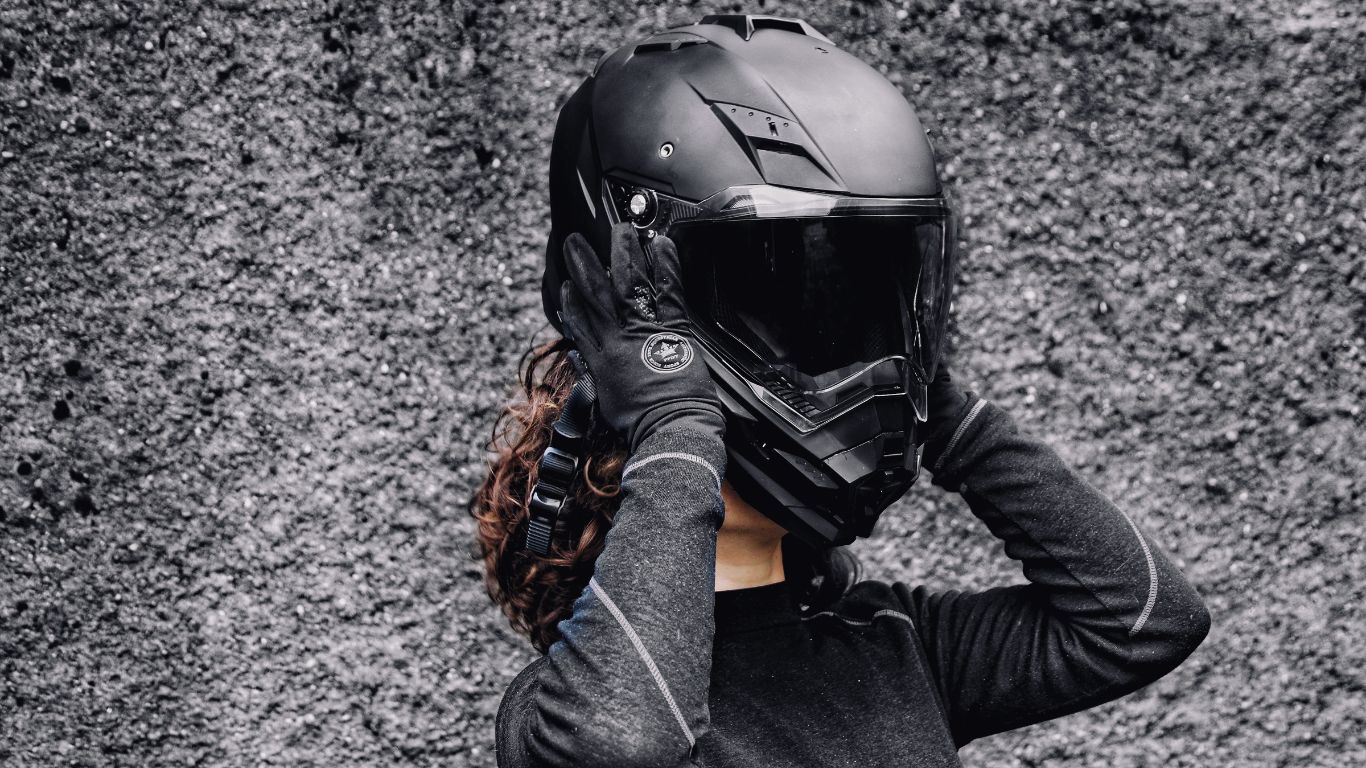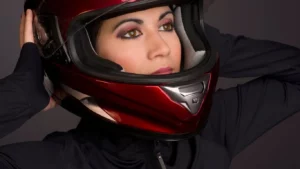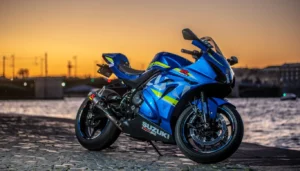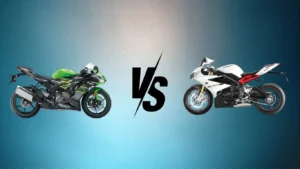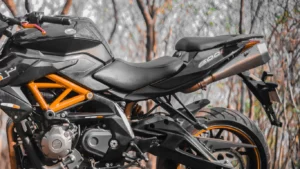Riding in the rain is difficult but occasionally unavoidable for motorcyclists. A suitable helmet can significantly enhance your safety and comfort during wet conditions. In this article, we will discuss the importance of choosing the right helmet for riding in the rain, explore essential features to consider, and present the top 5 motorcycle helmets for rain in 2024. We will also provide tips for maintaining your helmet’s optimal performance in rainy conditions.
Rain-Related Riding Challenges
1. Reduced visibility
When the heavens open, spotting traffic signals, obstructions, and fellow motorists can become a real challenge. It’s crucial to opt for a helmet equipped with a clear visor and anti-fog technology, ensuring those pesky water droplets don’t blur your vision on your ride.
2. Slippery surfaces
Riding on damp roads boosts the risk of slips and mishaps. Possessing a helmet that provides a snug and secure fit is crucial for safeguarding your skull should you tumble.
3. Impaired hearing
The drumming noise of rain and the roar of the wind can often drown out critical sounds from traffic and your fellow riders. A helmet equipped with noise-dampening features can boost your alertness and enhance your situational awareness when you’re out on the road.
4. Additional wind resistance
Stormy weather can create extra wind pressure that can potentially disrupt your riding equilibrium. A properly sized helmet can help reduce wind resistance’s influence in your journey.
Key Features to Look for in a Rain-Ready Motorcycle Helmet
Riding in the rain requires some added considerations. In addition to waterproof material, integrated Bluetooth technology, and a double-layer sun visor, there are a few additional crucial features you should look for in a rain-ready helmet. These features will improve your comfort, safety, and overall riding experience under wet and slippery conditions.
Anti-Fog and Anti-Water Shield
In the rain, it’s all about visibility. An anti-fog and anti-water shield is crucial for maintaining a clear line of sight. These special shields are designed to resist fogging, which can occur due to differences in atmospheric conditions, and water runoff, ensuring that your vision remains unaffected no matter how heavy the downpour.
Moisture-Wicking Interior Padding
The inside of the helmet should not be neglected. Look for a helmet that has moisture-wicking interior padding. This type of material works to absorb and evaporate sweat, preventing it from dripping into your eyes. Especially on long rides in the rain, this feature can greatly enhance your comfort.
Durable Exterior Shell
The external shell of the helmet is your first line of protection against impact and weather elements. It’s critical that the helmet you choose has a tough, durable exterior shell. This is often made of high-quality thermoplastic or composite fiber (carbon fiber, fiberglass, Kevlar). These materials not only offer excellent resistance to impacts, they are also waterproof, making them ideal for riding under the rain.
Secure Visor Lock
Last but by no means least, a secure visor lock can make a big difference to your riding experience in the rain. This feature ensures that the visor stays in place, even when faced with heavy wind or rain. A visor that keeps popping open can quickly turn a pleasant ride into a strenuous struggle, deflecting your focus away from the road. A proper visor lock gives you peace of mind and lets you concentrate on enjoying your ride in the rain.
Waterproof Material
Riding in the rain means dealing with moisture, so having a helmet made of waterproof material is on top of the list. This will help keep your head dry while you traverse through weather-downed roads. Waterproof helmets often have a laminated exterior that prevents water ingress, enhancing your comfort throughout your ride.
Integrated Bluetooth Technology
With the technological advancements, many helmets now come integrated with Bluetooth. This feature, which meets both DOT FMVSS 218 and ECE 22.05 standards, allows you to stay connected without compromising safety on the road. You can pair it with your mobile phone, listen to music, and even get directions, making your ride smoother even in rainy conditions.
Double Layer Sun Visor
A hallmark of a great rain-ready helmet is the presence of a double-layer sun visor. This feature offers heightened protection from the elements – rain, wind, insects, and even the blinding glare of the sun. The two layers work in harmony to provide you with clear visibility that’s crucial in ensuring safe rides during rainfall.
Complementary Gear
A rain-ready helmet is best complemented with other waterproof riding gear. Think motorcycle gloves to keep your hands dry and warm, and waterproof boots paired with waterproof pants for extended protection. Investing in quality waterproof gear will certainly improve your rainy weather riding experience markedly.
Top 5 Motorcycle Helmets for Rain in 2024
In this section, we present our top 5 motorcycle helmets for rain in 2024, with an overview of their features, pros, and cons.
1. YEMA YM-627 Motorcycle Half Helmet
Key Features:
- Lightweight ABS shell construction
- Comfortable and removable inner padding
- Adjustable chin strap for a secure fit
- Drop-down sun visor for added protection
Pros:
- Extremely lightweight design provides comfort during long rides and reduces neck fatigue
- Removable and washable inner padding allows for easy cleaning and customization for optimal comfort
- Adjustable chin strap ensures a secure and comfortable fit for various head sizes
- Convenient drop-down sun visor provides additional eye protection during bright or sunny conditions, even in wet weather
Cons:
- Half helmet design may not provide the same level of protection as full-face helmets in the event of an accident
- Limited anti-fog capabilities and reduced noise reduction due to the open face design
The YEMA YM-627 Motorcycle Half Helmet is an excellent choice for riders who prioritize a lightweight design without compromising on comfort and essential features.
With its lightweight ABS shell construction, removable padding, adjustable chin strap, and drop-down sun visor, this helmet offers a comfortable and convenient option for rainy weather riding.
However, it is important to note that the half helmet design may not provide the same level of protection and noise reduction as full-face helmets.
2. FreedConn Motorcycle Bluetooth Helmets
Key Features:
- Integrated Bluetooth 3.0 technology for seamless device connectivity
- Built-in intercom system with a range of up to 1640 feet (500 meters)
- One-touch control for easy access to calls, music, and GPS navigation
- Durable polycarbonate shell with advanced ventilation system
Pros:
- Effortless connection to smartphones and other Bluetooth-enabled devices for hands-free communication, music, and GPS navigation
- Built-in intercom system allows for convenient communication with other riders within range, enhancing group ride experience
- One-touch control simplifies the process of managing calls, music, and GPS navigation, allowing riders to focus on the road
- Sturdy polycarbonate shell construction and advanced ventilation system provide protection and comfort during wet weather rides
Cons:
- Battery life may be shorter compared to some other Bluetooth helmet models
- Top-of-the-line rainy weather helmets have better noise reduction and anti-fog.
The FreedConn Motorcycle Bluetooth Helmet offers an excellent combination of connectivity and functionality for riders who value seamless communication and device integration during their rides.
This helmet keeps riders connected and focused on the road in rainy weather with Bluetooth 3.0, an intercom system, and one-touch control. This helmet’s noise reduction and anti-fog characteristics may not be as good as those of other rain helmets.
4. AHR Motorcycle Helmet Dual Visor Modular
Certainly! The AHR Motorcycle Helmet Dual Visor Modular has two visors. Riders can adapt to different lighting conditions with the dual visor system’s clear and tinted visors.
The rider’s face is shielded from wind, debris, and insects by the outer clear visor. For long-term visibility, it is usually made of scratch-resistant material.
Key Features:
- Riders can choose between clear and tinted visors depending on lighting.
- The helmet’s front can be flipped up to make it an open-face helmet for ventilation.
- A strong outer shell and impact-absorbing padding protect the helmet.
- Adjustable straps and ventilation reduce fogging and improve comfort.
- Durable materials and scratch-resistant visors make the helmet last.
Pros:
- Dual visors offer flexibility in different lighting conditions. The tinted visor blocks sun and reduces glare, while the clear visor lets you see the road.
- The flip-up front section converts the helmet from a full-face to an open-face style for better ventilation and face access.
- A strong outer shell and impact-absorbing padding protect the helmet.
- Adjustable straps and ventilation reduce fogging and improve riding comfort.
- Durable materials and scratch-resistant visors make helmets last.
Cons:
- Due to the modular mechanism and parts, modular helmets are heavier than traditional full-face helmets.
- Compared to a full-face helmet, an open-face helmet may reduce stability at high speeds.
- Due to air gaps around the modular joint, modular helmets may make more wind noise than full-face helmets.
- Compared to open-face or half-face helmets, modular helmets may limit peripheral vision.
- Due to their added features and functionality, modular helmets cost more than full-face helmets.
AHR Motorcycle Helmet Dual Visor Modular has many motorcycle rider-friendly features. Its modular design lets you switch between full-face and open-face styles, and its dual visor system adapts to different lighting conditions.
A strong shell and impact-absorbing padding make the helmet safe. Adjustable straps and ventilation make it comfortable. The AHR Motorcycle Helmet Dual Visor Modular is a versatile and protective helmet for riders who want versatility and functionality. Its drawbacks include weight and noise.
5. 1STORM Motorcycle Bike Full FACE Helmet
Key Features:
- Lightweight and durable aerodynamic thermoplastic alloy shell
- Removable and washable padding for easy maintenance
- UV-protective and anti-scratch visor for clear vision
- Quick-release buckle for easy and secure fastening
- Meets DOT safety standards
Pros:
- Affordable option without compromising on essential features for wet weather riding
- Lightweight thermoplastic alloy shell provides comfort and durability
- Removable and washable padding ensures easy cleaning and allows for customization of the helmet’s interior for optimal comfort
- UV-protective and anti-scratch visor offers clear vision and eye protection during wet and sunny rides
- Quick-release buckle enables riders to easily fasten and unfasten the helmet for added convenience
Cons:
- May not provide the same level of noise reduction and anti-fog capabilities as more expensive models
- Limited ventilation options compared to higher-end helmets
The 1STORM Motorcycle Bike Full FACE Helmet offers an excellent budget-friendly option for riders seeking essential wet weather features without breaking the bank.
The helmet’s lightweight and durable thermoplastic alloy shell, removable padding, UV-protective visor, and quick-release buckle combine to provide a comfortable and convenient riding experience in the rain.
However, it is important to note that this budget helmet may not offer the same level of noise reduction and anti-fog capabilities as more expensive models and may have limited ventilation options compared to higher-end helmets.
Technology Behind Anti-fog Helmets
The technology behind anti-fog helmets is quite fascinating. It’s like a superhero gadget – working mysteriously to combat the villainous fog that can often impair your vision during rainy rides. But what’s really going on behind the scenes?
First, you should know that these helmets have a special coating on the interior side of the visor. This substance, often referred to as an anti-fog treatment, works to disperse the moisture that accumulates when the temperature inside your helmet differs from the outside environment. Indeed, under normal circumstances, this moisture would coalesce into tiny droplets, clouding your visor with a fine mist. But thanks to the anti-fog coating, water droplets spread out, forming a thin, transparent layer that allows for clear vision.
Some helmets, however, take this technology to another level with heated visors. Yes, you read that right – heated visors! Using a tiny heating element embedded within the visor, these helmets can efficiently disperse the fog-inducing humidity, thereby allowing for a clear vision, no matter how wet or cold the ride gets.
It’s worth noting that this anti-fog technology can wear off over time due to regular usage or incorrect cleaning methods. Luckily, many manufacturers offer anti-fog sprays which you can use to reapply the coating and reclaim your helmet’s fog-fighting prowess.
In a nutshell, anti-fog helmets are your trusty sidekick for riding in wet weather, ensuring that you always have clear vision and stay safe on the road.
Helmet Accessories You Need for Riding in the Rain
- Waterproof Gloves: A pair of quality waterproof motorcycle gloves can keep your hands warm and dry, ensuring a secure grip on the handles in the rain.
- Waterproof Boots: Pairing your helmet with waterproof boots can protect your feet and lower legs from water splashes, keeping you comfortable even on long rides in wet weather conditions.
- Train Layering: For those who ride frequently, packable waterproof layers are crucial. They keep the rider dry and are easy to pack in a backpack or a saddlebag. Brands like REVIT! or Frogg Toggs have excellent options for the rain suit.
- Waterproof Motorcycle Pants: These pants are additional gear to consider when making the full switch to rain-ready riding gear. They offer extra protection from the rain, particularly when matched with waterproof boots.
- Helmet Cover: A helmet cover can provide an additional layer of protection to prevent water from seeping into the helmet through vents and other openings, enhancing your comfort in the rain.
- Anti-Fog Spray: An Anti-fog spray can be used on the visor to increase visibility by preventing fog formation, which is more common during the rainy season.
Frequently Asked Questions (FAQs)
You might still have a couple of questions lingering in your mind. Don’t worry, you’re certainly not alone. This section targets some of the most commonly asked questions regarding the best motorcycle helmets for riding in the rain in 2024.
Question: What is the purpose of anti-fog technology in motorcycle helmets?
Answer: Anti-fog technology in helmets makes sure that your vision remains crystal clear, even under damp and rainy conditions. It often works by forming a barrier that prevents water vapor from condensing on the visor’s surface, thus maintaining visibility and enhancing safety.
Question: Why do motorcycle helmets have moisture-wicking interiors?
Answer: Moisture-wicking interior padding in a helmet helps draw sweat and rain away from your skin, keeping you dry and comfortable during the ride. This feature comes in handy especially during long trips or rides in wet conditions.
Question: How important is a secure visor lock during rainy rides?
Answer: A secure visor lock is essential when riding in the rain. It prevents the visor from inadvertently flipping open, thereby ensuring uninterrupted visibility and protecting against the sudden influx of rain, wind, or debris. Look for helmets with easy-to-use yet secure locks that you can operate even with your gloves on.
Question: What does it mean if a helmet has integrated Bluetooth technology?
Answer: Helmets with integrated Bluetooth technology let you stay connected on the road. They give you hands-free access to your phone for calls and music, and some also offer voice-activated digital assistant access or antennas that allow communication with other riders. Models like the FreedConn Motorcycle Bluetooth Helmet mentioned earlier utilize this technology flawlessly.
Question: Can I add accessories to make my regular helmet rainproof?
Answer: Absolutely! There are many accessories available in the market that can enhance your helmet’s rain-ready capabilities. That said, it may not provide the same level of protection and comfort as a well-crafted rain-specific helmet.”
Question: How do I maintain and care for my rain helmet?
Answer: Rain helmets require the same care as any other helmet. Keep the exterior clean, rinsing off any dirt or grime that can damage the outer shell. Dry the helmet properly after each rain ride to prevent moisture buildup. And most importantly, handle it with care to avoid damaging the safety features and technology inside.
